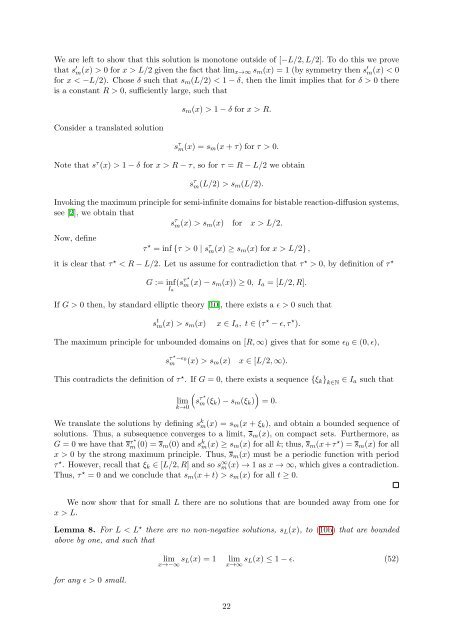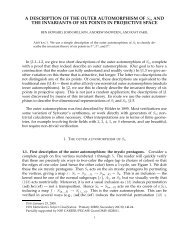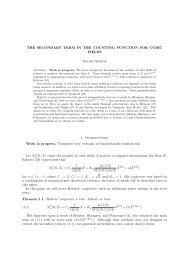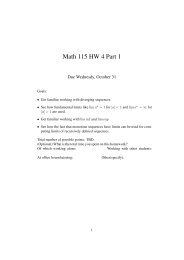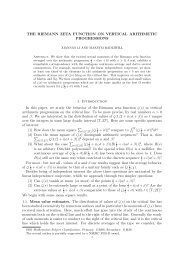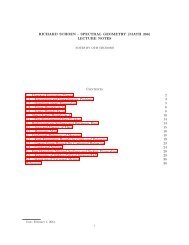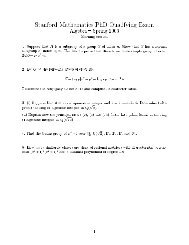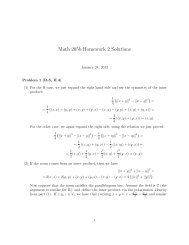Traveling Wave Solutions in a Reaction-Diffusion Model for Criminal ...
Traveling Wave Solutions in a Reaction-Diffusion Model for Criminal ...
Traveling Wave Solutions in a Reaction-Diffusion Model for Criminal ...
Create successful ePaper yourself
Turn your PDF publications into a flip-book with our unique Google optimized e-Paper software.
We are left to show that this solution is monotone outside of [−L/2, L/2]. To do this we prove<br />
that s ′ m(x) > 0 <strong>for</strong> x > L/2 given the fact that limx→∞ sm(x) = 1 (by symmetry then s ′ m(x) < 0<br />
<strong>for</strong> x < −L/2). Chose δ such that sm(L/2) < 1 − δ, then the limit implies that <strong>for</strong> δ > 0 there<br />
is a constant R > 0, sufficiently large, such that<br />
Consider a translated solution<br />
sm(x) > 1 − δ <strong>for</strong> x > R.<br />
s τ m(x) = sm(x + τ) <strong>for</strong> τ > 0.<br />
Note that s τ (x) > 1 − δ <strong>for</strong> x > R − τ, so <strong>for</strong> τ = R − L/2 we obta<strong>in</strong><br />
s τ m(L/2) > sm(L/2).<br />
Invok<strong>in</strong>g the maximum pr<strong>in</strong>ciple <strong>for</strong> semi-<strong>in</strong>f<strong>in</strong>ite doma<strong>in</strong>s <strong>for</strong> bistable reaction-diffusion systems,<br />
see [2], we obta<strong>in</strong> that<br />
s τ m(x) > sm(x) <strong>for</strong> x > L/2.<br />
Now, def<strong>in</strong>e<br />
τ ⋆ = <strong>in</strong>f {τ > 0 | s τ m(x) ≥ sm(x) <strong>for</strong> x > L/2} ,<br />
it is clear that τ ⋆ < R − L/2. Let us assume <strong>for</strong> contradiction that τ ⋆ > 0, by def<strong>in</strong>ition of τ ⋆<br />
G := <strong>in</strong>f<br />
Ia<br />
τ ⋆<br />
(sm (x) − sm(x)) ≥ 0, Ia = [L/2, R].<br />
If G > 0 then, by standard elliptic theory [10], there exists a ɛ > 0 such that<br />
s t m(x) > sm(x) x ∈ Ia, t ∈ (τ ⋆ − ɛ, τ ⋆ ).<br />
The maximum pr<strong>in</strong>ciple <strong>for</strong> unbounded doma<strong>in</strong>s on [R, ∞) gives that <strong>for</strong> some ɛ0 ∈ (0, ɛ),<br />
s τ ⋆ −ɛ0<br />
m (x) > sm(x) x ∈ [L/2, ∞).<br />
This contradicts the def<strong>in</strong>ition of τ ⋆ . If G = 0, there exists a sequence {ξk} k∈N ∈ Ia such that<br />
<br />
<br />
τ ⋆<br />
lim sm (ξk) − sm(ξk)<br />
k→0<br />
We translate the solutions by def<strong>in</strong><strong>in</strong>g sk m(x) = sm(x + ξk), and obta<strong>in</strong> a bounded sequence of<br />
solutions. Thus, a subsequence converges to a limit, sm(x), on compact sets. Furthermore, as<br />
G = 0 we have that sτ ⋆<br />
m (0) = sm(0) and sk m(x) ≥ sm(x) <strong>for</strong> all k; thus, sm(x+τ ⋆ ) = sm(x) <strong>for</strong> all<br />
x > 0 by the strong maximum pr<strong>in</strong>ciple. Thus, sm(x) must be a periodic function with period<br />
τ ⋆ . However, recall that ξk ∈ [L/2, R] and so s∞ m (x) → 1 as x → ∞, which gives a contradiction.<br />
Thus, τ ⋆ = 0 and we conclude that sm(x + t) > sm(x) <strong>for</strong> all t ≥ 0.<br />
We now show that <strong>for</strong> small L there are no solutions that are bounded away from one <strong>for</strong><br />
x > L.<br />
Lemma 8. For L < L ⋆ there are no non-negative solutions, sL(x), to (10b) that are bounded<br />
above by one, and such that<br />
<strong>for</strong> any ɛ > 0 small.<br />
= 0.<br />
lim<br />
x→−∞ sL(x) = 1 lim<br />
x→∞ sL(x) ≤ 1 − ɛ. (52)<br />
22


